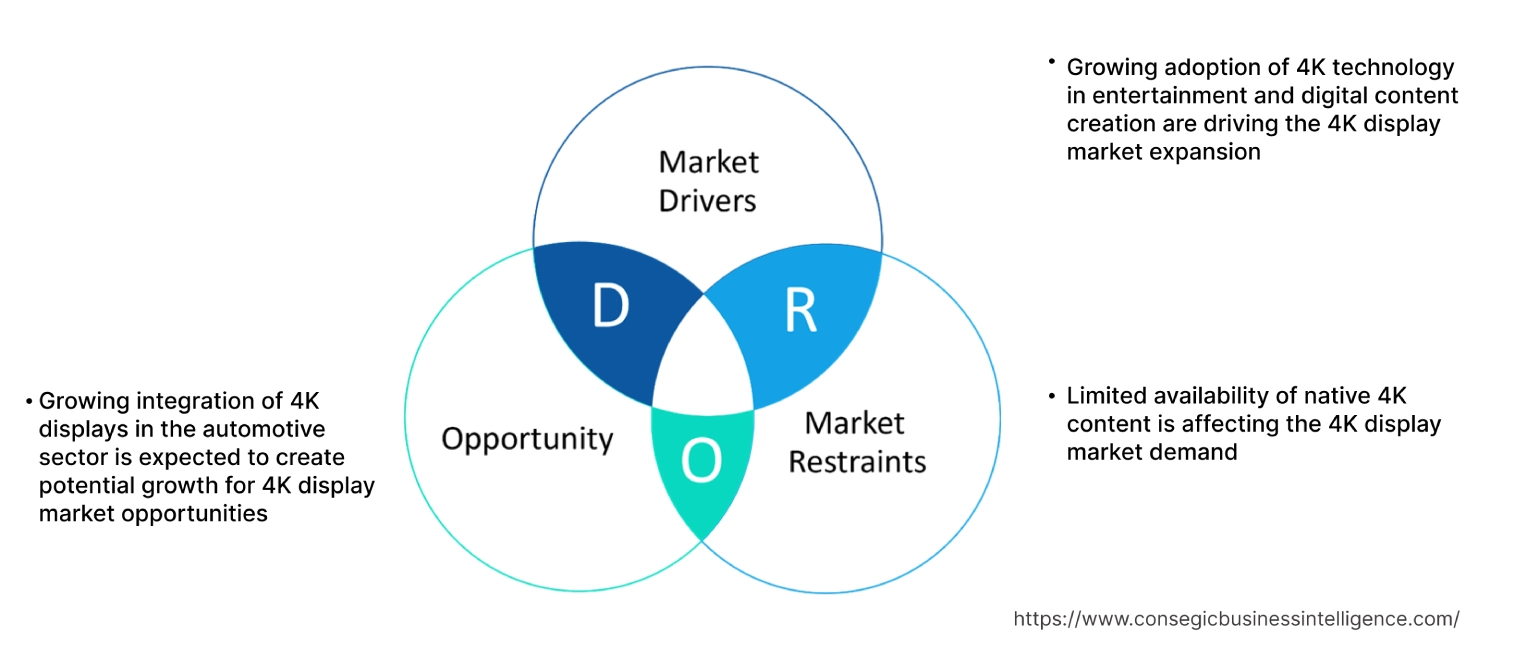- Summary
- Table Of Content
- Methodology
4K Display Market Size:
4K Display Market Size is estimated to reach over USD 490.83 Billion by 2032 from a value of USD 127.21 Billion in 2024 and is projected to grow by USD 148.39 Billion in 2025, growing at a CAGR of 16.1% from 2025 to 2032.
4K Display Market Scope & Overview:
4K display refers to display with a resolution of 3480*2160 pixels, while offering fourfold increase in pixel density as compared to full high definition (FHD). It offers better clarity and detail, transforming viewing experiences in entertainment, gaming, advertising, and professional applications. Consumers are increasingly seeking immersive visual experiences, which is encouraging manufacturers to innovate and introduce a wide range of 4K-enabled devices. Additionally, industries such as healthcare, education, and retail are adopting 4K displays for enhanced visualization, interactive learning, and impactful advertising.
Key Drivers:
Growing adoption of 4K technology in entertainment and digital content creation are driving the 4K display market expansion
The adoption of 4K technology in entertainment and digital content creation has reformed visual storytelling and viewing experiences across various media platforms. Content creators, including filmmakers, streaming services, and broadcasters, have increasingly embraced 4K resolution for its ability to deliver incredibly detailed and cinematic visuals. This technology allows for sharper images, richer colors, and enhanced clarity, enhancing the overall quality of content consumed by audiences worldwide.
Further, streaming platforms and broadcasters are also leveraging 4K resolution to meet the growing consumer need for high-definition content, offering viewers immersive and cinematic experiences in the comfort of their homes. This adoption has not only raised the barrier for visual quality but has also driven the upgrade to 4K-capable infrastructure and distribution channels.
- For instance, in March 2023, Sony enhanced its BRAVIA XR 4K TV range by adding the cognitive processor XR. This chip analyzes the surroundings and improve both picture and sound quality. Additionally, Sony highlighted its BRAVIA CORE streaming service, which provides users with high-quality 4K content similar to Blu-ray discs.
Thus, according to the 4K display market analysis, the growing adoption of 4K technology in the entertainment sector is driving the 4K display market size.
Key Restraints:
Limited availability of native 4K content is affecting the 4K display market demand
While the demand for 4K-capable display devices has grown rapidly, the production and availability of content in true 4K resolution is still limited. This limitation arises from various factors, including higher production costs and bandwidth requirements associated with creating and distributing 4K content.
Content creators, such as filmmakers and broadcasters, often face difficulties in transitioning to 4K production due to the need for specialized equipment and infrastructure. Additionally, the storage and transmission of large 4K files require strong network capabilities, which may not be universally accessible or cost-effective. As a result, much of the content available on the streaming platforms is in lower resolutions, which affects the perceived value and utility of investing in 4K display devices for consumers and businesses. Therefore, the above analysis depicts that the aforementioned factors would further impact the 4K display market size.
Future Opportunities :
Growing integration of 4K displays in the automotive sector is expected to create potential growth for 4K display market opportunities
The integration of 4K displays in the automotive sector is transforming in-car entertainment and navigation systems. Automakers are increasingly incorporating 4K technology into dashboards and rear-seat entertainment systems to enhance the overall driving experience. These high-resolution displays offer crisp visuals and detailed graphics, improving the visibility of navigation maps, real-time traffic information, and multimedia content. Additionally, these displays are being utilized in digital rear-view mirrors and augmented reality (AR) head-up displays (HUDs), providing drivers with enhanced safety features and immersive driving experiences.
- For instance, in November 2024, Audi launched new electric car brand, Audi E, for Chinese market. This car features a substantial 100-kWh battery, allowing it to travel up to 700 kilometers on a single charge. Inside the car, the center console features a striking, 4K touchscreen display, providing a highly intuitive and accessible way to view vehicle information. Additionally, traditional side mirrors are replaced with digital ones, with their feeds integrated directly into this panoramic display.
Thus, based on the above 4K display market analysis, the growing integration of 4K displays in the automotive sector is expected to drive the 4K display market opportunities and trends.
4K Display Market Segmental Analysis :
By Display Technology:
Based on display technology, the market is segmented into LCD, OLED, mini LED, and micro LED.
Trends in the display technology:
- The shift towards high-resolution displays and large-screen applications has spurred the need for advanced display solutions. As a result, key players in the market are investing heavily in research and development to meet the evolving needs of the market.
- The development of the consumer electronics market, with a rise in need for high-resolution displays, further boosts the segment growth. Thus, the above factors are driving the 4K display market demand.
The LCD segment accounted for the largest revenue in the year 2024.
- Innovations such as improved pixel densities, enhanced color accuracy, and faster refresh rates have elevated the performance standards of LCDs, making them more appealing to consumers and industries.
- Additionally, the shift towards larger screen dimensions and the integration of touch functionalities have further propelled the need for LCDs.
- The proliferation of smartphones, tablets, laptops, and automotive displays has significantly contributed to the widespread adoption of touchscreen-enabled thin film transistor (TFT) LCDs.
- As touchscreens become a standard feature in consumer electronics and industrial applications, manufacturers are continuously innovating to improve responsiveness, durability, and multi-touch capabilities, further propelling the segment growth.
- For instance, in February 2022, Sharp Imaging and Information Company of America (SIICA) launched PN-HY 4K Ultra-HD professional and PN-HS LCD monitor series. The PN-HY and PN-HS professional display series will be offered in three screen dimensions including 55 inches, 50 inches, and 43 inches.
- Thus, based on the above developments, these factors are further driving the 4K display market growth.
The OLED segment is anticipated to register the fastest CAGR during the forecast period.
- OLED displays are known for their superior picture quality, high contrast ratios, wide viewing angles, and energy efficiency as compared to traditional LCD displays. These attributes are increasing the adoption of OLED technology across a range of applications, including smartphones, televisions, automotive displays, and wearable devices.
- The emphasis on sustainability and reducing environmental impact has increased the appeal of energy-efficient technologies across various industry verticals. Consumers and manufacturers are prioritizing eco-friendly solutions, and OLED displays align well with these values due to their lower power consumption and potential for reduced carbon footprints.
- For instance, in August 2024, Samsung planned to reduce the power consumption of its OLED sections by over 50% by developing technologies to contribute to energy efficiency goals. The company has started working on OLEDs architecture, and high efficacy blue PHOLED emitters.
- Thus, based on the above analysis, these factors are expected to drive the 4K display market share during the forecast period.
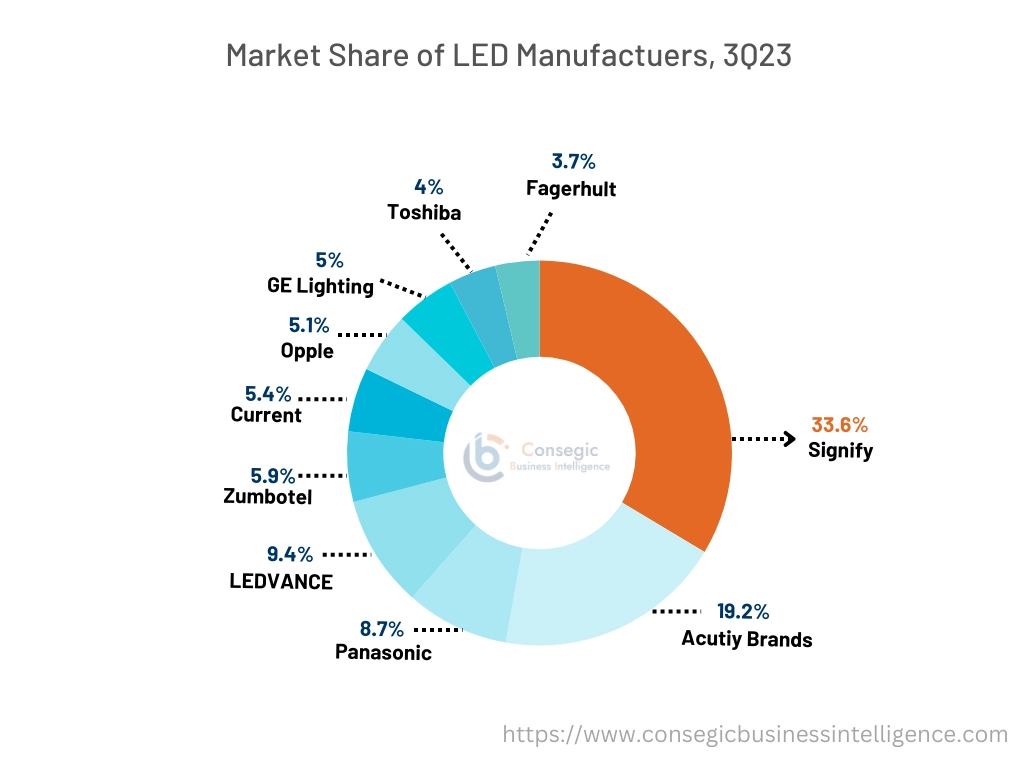
By Screen Size:
Based on screen size, the market is segmented into below 50 inches, 51-65 inches
66-75 inches, and above 75 inches.
Trends in the screen size:
- Manufacturers are investing heavily in research and development to create chips that can handle the increased data throughput necessary for ultra-high-definition content. This development is amplified by the growing popularity of large-screen TVs in both home entertainment and commercial settings, where image clarity and color accuracy are necessary.
- As businesses and organizations continue to recognize the value of visual communication, the need for large format displays is expected to rise, supported by ongoing technological advancements and decreasing costs of high-quality display panels.
The below 50 inches accounted for the largest revenue in the year 2024.
- The advancement of 4K gaming technologies and next-generation consoles like PlayStation 5 and Xbox Series X are driving gamers to upgrade to 4K TVs below 50 inches for optimal performance with high refresh rates and low latency.
- The increasing popularity of smart TVs, which come standard with 4K resolution and integrated streaming apps, contributes to the demand for smaller displays.
- For instance, Xiaomi offer 43 inches smart TV in its product offerings, which provides 4K resolution with enhanced color and clarity. The TV has 94% DCI-P3 color accuracy.
- Thus, based on the above analysis, these factors would further supplement the 4K display market
The 51-65 inches segment is anticipated to register the fastest CAGR during the forecast period.
- The 51–65-inches range is popular for its balance of screen dimensions and affordability, offering a cinematic experience for home entertainment.
- Consumers are continuously seeking superior picture quality with more detail, vibrant colors, and sharper images, driving the need for 4K UHD TVs in this range.
- The availability of 4K content from streaming services like Netflix, Amazon Prime Video, and Disney+, as well as 4K Blu-ray and gaming, fuels this requirement.
- For instance, LG’s 65 inches LED smart TV is ideal for a large and cinematic experience. It has improved audio with AI-driven sound for better listening. Furter, it also features Alpha 7 AI Processor 4K Gen6, Smart WebOS platform with OTT apps, such as Disney+ Hotstar, Prime Video, and Netflix.
- These factors are anticipated to further drive the 4K display market trends during the forecast period.
By End User:
Based on the end user, the market is segmented into consumer electronics, commercial displays, broadcasting, and gaming.
Trends in the end user:
- The growing advancements in display technology, such as higher resolution, improved brightness, and enhanced durability, are driving the demand for display products across sectors such as retail, education, corporate, healthcare, and transportation.
- The continuous innovation in display features and the increasing preference for visually engaging and dynamic content are propelling the growth of the segment.
The consumer electronics segment accounted for the largest revenue share of 38.11% in the year 2024.
- Televisions, monitors, projectors, and smartphones with 4K resolution have become more accessible to consumers, driven by advancements in display technology and economies of scale in manufacturing.
- As a result, consumers are increasingly replacing their older HD devices with 4K models to enjoy superior visual quality and immersive viewing experiences, thereby driving market growth.
- Consumers seeking an immersive home entertainment experience are driving the adoption of OLED TVs, which are recognized for delivering superior visual performance.
- For instance, in June 2024, Samsung introduced its QLED 4K TV lineup in India, which leverages quantum dot technology and 4K upscaling. These features aim to deliver a superior viewing experience with accurate colors and high contrast, targeting Indian consumers, particularly those who enjoy premium gaming and 4K content.
- Thus, based on the above analysis, these factors are driving the 4K display market growth.
The gaming segment is anticipated to register the fastest CAGR during the forecast period.
- For esports and competitive gaming, high-performing monitors with fast response times, high refresh rates, and low input lag are essential for better accuracy and smoother gameplay.
- Furthermore, professional gamers investing in top-tier equipment to boost their performance influences consumer choices and drives trends in the gaming market.
- The vast viewership of esports tournaments on platforms like Twitch and YouTube also exposes a wide audience to advanced gaming technology, sparking interest in replicating the professional gaming setup at home.
- For instance, in January 2024, LG Electronics renewed its partnership with the globally recognized esports organization, Gen.G Esports. As part of this ongoing collaboration, Gen.G's professional teams will continue to receive LG UltraGear gaming monitors, known for their high refresh rates and overall performance.
- These factors are anticipated to further drive the 4K display market trends and growth during the forecast period.
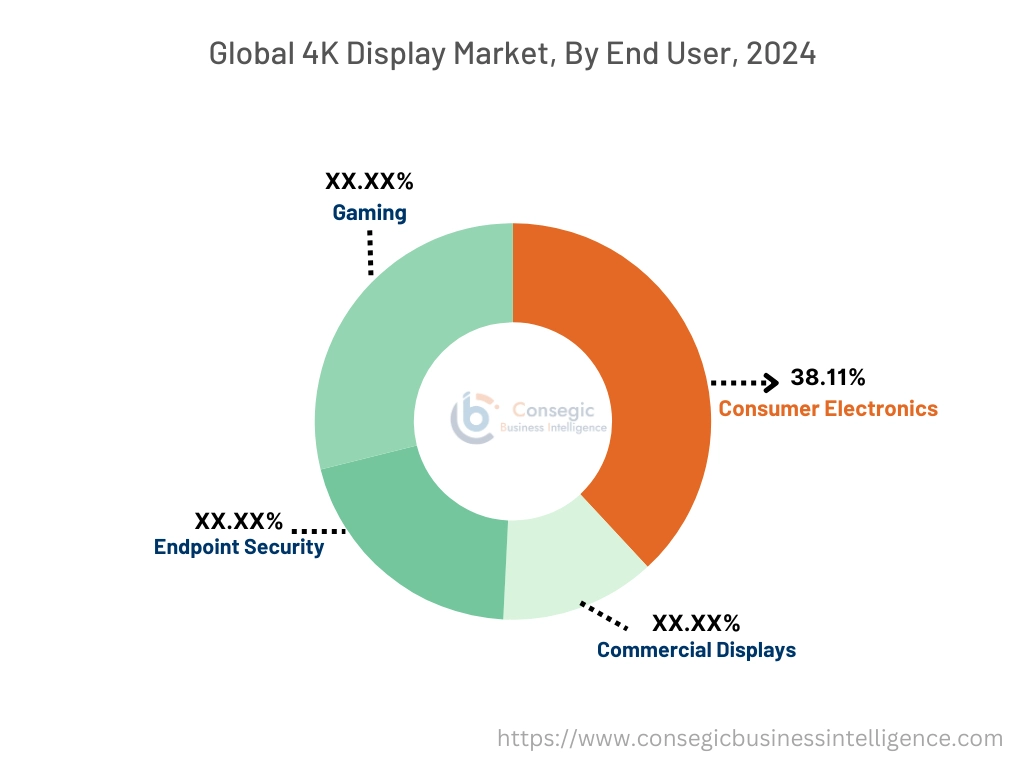
By Aspect Ratio:
Based on aspect ratio, the market is segmented into 16:9, 21:9, and 4:3.
Trends in the aspect ratio:
- 4K monitors features a high pixel density, resulting in exceptionally sharp and detailed visuals, which makes them ideal for tasks such as photo editing, video production, and graphic design.
- The increased pixel density of 4K monitors enables users to display more content simultaneously while enhancing productivity for tasks such as video editing, spreadsheet analysis, and multitasking. By offering four times the pixels of 1080p screens, these displays provide a more expensive and efficient workspace.
The 16:9 segment accounted for the largest revenue share in the year 2024 and it is expected to register the highest CAGR during the forecast period.
- The 16:9 aspect ratio is suited for displaying high-definition and ultra-high-definition content without black bars or distortion, which accommodates a wide range of content, from cinematic productions to everyday television broadcasts and gaming.
- 16:9 screens are ideally designed to showcase HD resolutions, eliminating the need for black bars on the top and sides, which enables viewers to experience the entire visual content as intended.
- Video editing software such as Adobe Premiere Pro and Final Cut Pro are optimized for 16:9 workflows, making it the standard for content creators.
- Therefore, the above factors are driving the global market.
By Resolution Enhancement:
Based on resolution enhancement, the market is segmented into upscaling technology, native 4K, and HDR support.
Trends in the resolution enhancement:
- Advanced scaling technologies, including AI-powered upscaling, enhance the sharpness and overall quality of lower-resolution content when viewed on high-resolution displays.
- Additionally, there is a growing trend among gamers and streamers to use multiple monitors with varying resolutions (Full HD, QHD, and 4K) to expand their screen real estate and increase productivity.
The high dynamic range (HDR) support segment accounted for the largest revenue in the year 2024 and it is expected to register the highest CAGR during the forecast period.
- As consumers increasingly prioritize superior visual experiences, smartphone manufacturers are responding by integrating HDR technology into their devices.
- HDR displays offer enhanced contrast, vibrant colors, and sharper details, significantly improving the viewing experience for users across various multimedia content such as videos, photos, and games.
- This increasing adoption of smartphones with HDR displays is reshaping the landscape of the segment, creating a robust ecosystem for HDR-enabled content consumption and creation.
- Content developers and streaming platforms are optimizing their offerings to leverage the capabilities of HDR displays, providing users with immersive and lifelike experiences on their handheld devices.
- Thus, based on the above factors, these developments in the HDR support segment are driving the global market.
Regional Analysis:
The regions covered are North America, Europe, Asia Pacific, the Middle East and Africa, and Latin America.
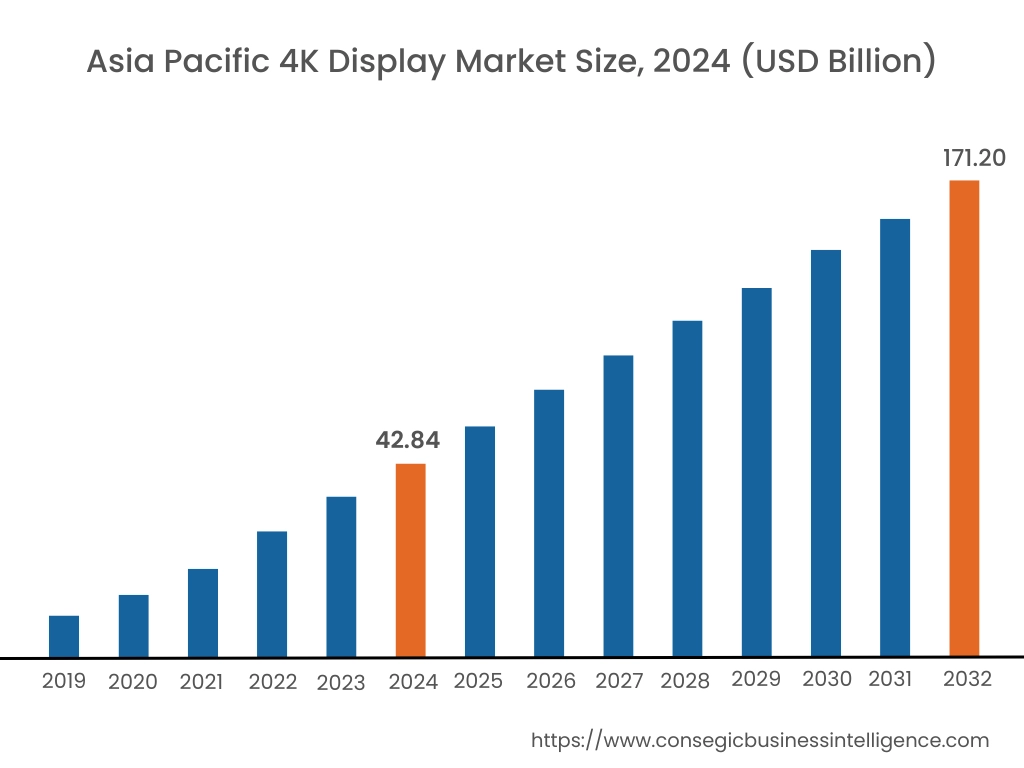
Asia Pacific 4K display market expansion is estimated to reach over USD 171.20 billion by 2032 from a value of USD 42.84 billion in 2024 and is projected to grow by USD 50.12 billion in 2025. Out of this, the China market accounted for the maximum revenue split of 35.76%. The regional market is significantly growing, driven by its large and diverse gamer base seeking both budget-friendly and high-end options. This expansion is further fueled by the increasing number of esports tournaments and gaming cafes, alongside the growing popularity of mobile and PC gaming. Further, the region's technological advancements and strong manufacturing capabilities also enable the availability of both affordable and advanced monitors. These factors would further drive the regional market during the forecast period.
- For instance, in May 2023, Samsung announced the partnership with International Olympic Committee, by providing its Galaxy smartphones, tablets, and Odyssey gaming monitors for esports tournaments and various public engagement activities.
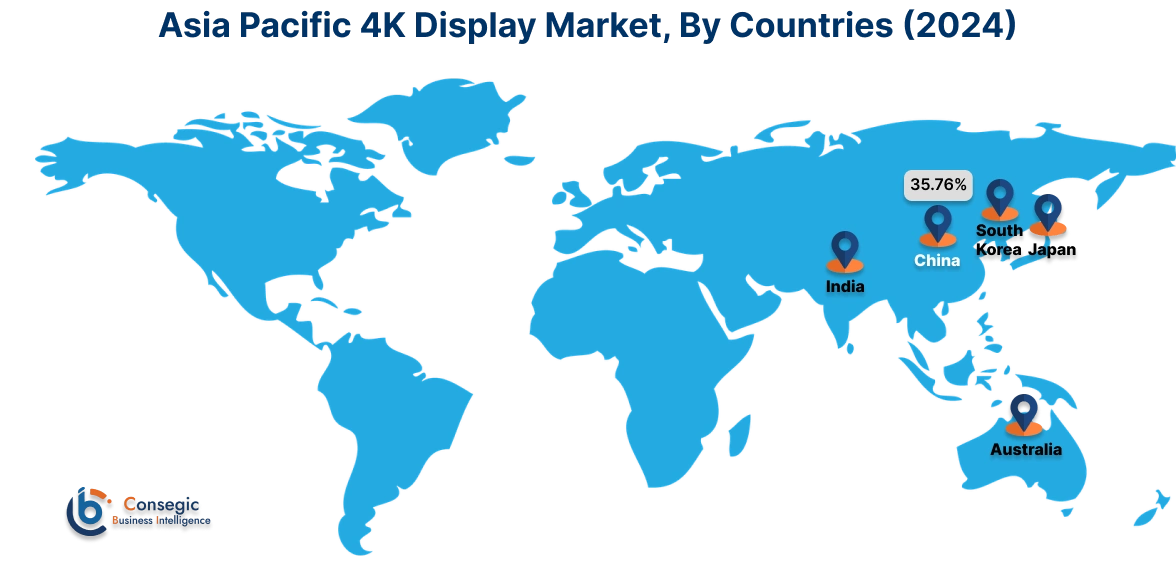
North America market is estimated to reach over USD 147.79 billion by 2032 from a value of USD 38.55 billion in 2024 and is projected to grow by USD 44.94 billion in 2025. North America holds a significant share in the market, driven by early adoption of advanced display technologies and strong demand from sectors such as entertainment, gaming, and healthcare. The region's high disposable income and preference for premium consumer electronics contribute to a significant revenue in the 4K display market, with companies like HP Inc. and Apple Inc. playing crucial roles. These factors would further boost the 4K display market in the region.
- For instance, in January 2024, HP Inc. launched a highly personalized gaming lineup, featuring state-of-the-art innovations across its OMEN and HyperX portfolios. This new suite of laptops, accessories, and software is engineered to work together smoothly, providing gamers with a cohesive ecosystem that allows for complete concentration on their gameplay.
Additionally, according to the analysis, the 4K display industry in Europe is projected to witness significant development during the forecast period. The region's emphasis on quality viewing experiences and technological innovation further boosts the adoption of 4K technology across various applications. Additionally, the Latin American countries are witnessing increasing adoption of 4K resolution technology in urban centers, driven by improving living standards and a growing middle class. Further, in the Middle East & Africa, countries are investing in upgrading their digital infrastructure, which is expected to drive the demand for 4K technology in sectors like retail and hospitality among others.
Top Key Players and Market Share Insights:
The global 4K display market is highly competitive with major players providing products to the national and international markets. Key players are adopting several strategies in research and development (R&D), product innovation, and end-user launches to hold a strong position in the market. Key players in the 4K display industry include-
- Apple Inc. (U.S.)
- Vizio (U.S.)
- HP Inc. (U.S.)
- Sony Corporation (Japan)
- Samsung Electronics (South Korea)
- TCL Technology (China)
- Dell Technologies (U.S.)
- Microsoft Corporation (U.S.)
- Panasonic Corporation (Japan)
- Philips (Netherlands)
- Acer (Taiwan)
- LG Display (South Korea)
- ASUS (Taiwan)
- Lenovo Group (Hong Kong)
- Sharp Corporation (Japan)
Recent Industry Developments :
Collaborations and Partnerships:
- In August 2023, Samsung Electronics announced the partnership with NEXON, to release a new gaming monitor that incorporates the HDR10+ GAMING standard, developed by HDR10+ Technologies LLC. This technology promises richer visuals with improved color depth, contrast, and brightness.
4K Display Market Report Insights :
| Report Attributes | Report Details |
| Study Timeline | 2019-2032 |
| Market Size in 2032 | USD 490.83 Billion |
| CAGR (2025-2032) | 16.1% |
| By Display Technology |
|
| By Screen Size |
|
| By End User |
|
| By Aspect Ratio |
|
| By Resolution Enhancement |
|
| By Region |
|
| Key Players |
|
| North America | U.S. Canada Mexico |
| Europe | U.K. Germany France Spain Italy Russia Benelux Rest of Europe |
| APAC | China South Korea Japan India Australia ASEAN Rest of Asia-Pacific |
| Middle East and Africa | GCC Turkey South Africa Rest of MEA |
| LATAM | Brazil Argentina Chile Rest of LATAM |
| Report Coverage |
|
Key Questions Answered in the Report
How big is the 4K Display Market? +
4K Display Market Size is estimated to reach over USD 490.83 Billion by 2032 from a value of USD 127.21 Billion in 2024 and is projected to grow by USD 148.39 Billion in 2025, growing at a CAGR of 16.1% from 2025 to 2032.
Which is the fastest-growing region in the 4K Display Market? +
Asia-Pacific is the region experiencing the most rapid growth in the market.
What specific segmentation details are covered in the 4K Display report? +
The 4K display report includes specific segmentation details for display technology, screen size, end user, aspect ratio, resolution enhancement, and region.
Who are the major players in the 4K Display Market? +
The key participants in the market are Apple Inc. (U.S.), Vizio (U.S.), HP Inc. (U.S.), Sony Corporation (Japan), Samsung Electronics (South Korea), TCL Technology (China), Dell Technologies (U.S.), Microsoft Corporation (U.S.), Panasonic Corporation (Japan), Philips (Netherlands), Acer (Taiwan), LG Display (South Korea), ASUS (Taiwan), Lenovo Group (Hong Kong), Sharp Corporation (Japan), and others.

